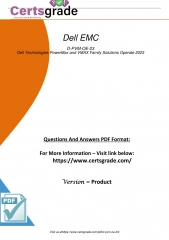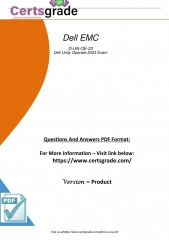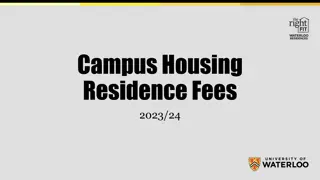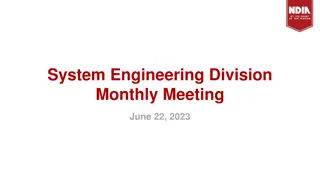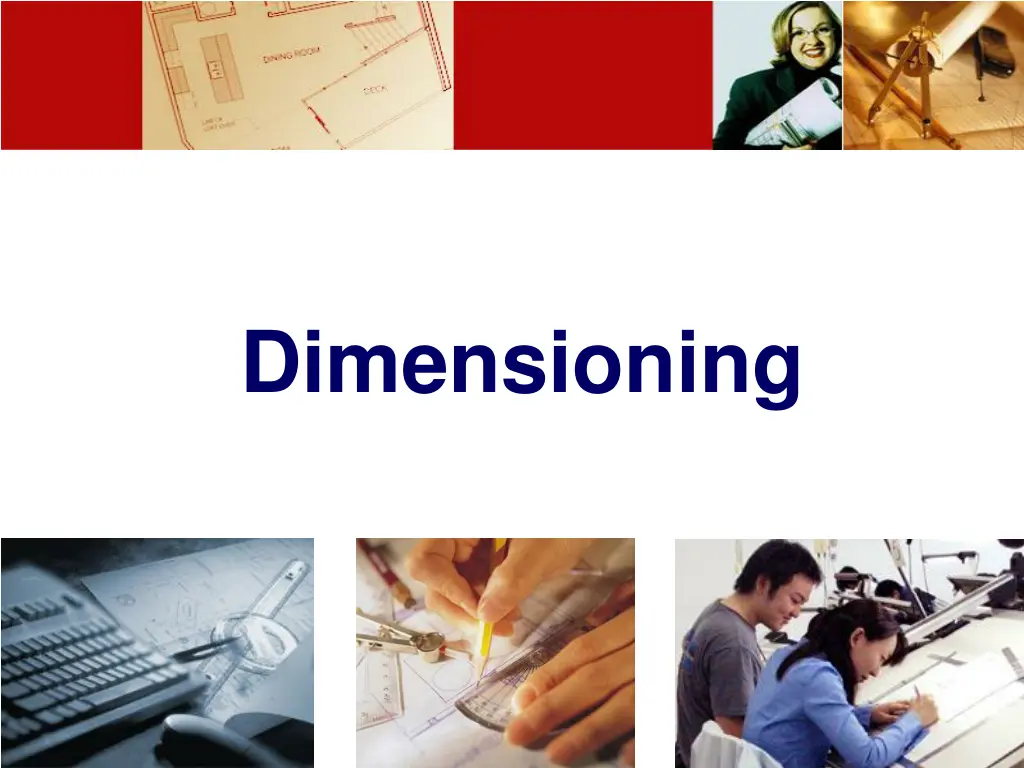
Effective Dimensioning Practices for Engineering Designs
Explore the significance of dimensioning in engineering design processes, understanding dimensioning components, systems, and recommended practices. Learn how to use extension lines, dimension lines, and leader lines effectively to convey part information accurately.
Download Presentation

Please find below an Image/Link to download the presentation.
The content on the website is provided AS IS for your information and personal use only. It may not be sold, licensed, or shared on other websites without obtaining consent from the author. If you encounter any issues during the download, it is possible that the publisher has removed the file from their server.
You are allowed to download the files provided on this website for personal or commercial use, subject to the condition that they are used lawfully. All files are the property of their respective owners.
The content on the website is provided AS IS for your information and personal use only. It may not be sold, licensed, or shared on other websites without obtaining consent from the author.
E N D
Presentation Transcript
TOPICS Introduction Dimensioning components Dimensioning object s features Placement of dimensions.
ENGINEERING DESIGN PROCESS RESULT TRANSFERRED INFORMATION Design a part Sketches of ideas Multiview Drawing Shape Create drawings 1. Size, Location 2. Non-graphic information Dimensioning Manufacture
DEFINITION Dimensioning is the process of specifying part s information by using of figures, symbols and notes. This information are such as: 1. Sizes and locations of features This course 2. Material s type 3. Number required 4. Kind of surface finish 5. Manufacturing process 6. Size and geometric tolerances
DIMENSIONING SYSTEM 1. Metric system : ISO and JIS standards This course Examples 32, 32.5, 32.55, 0.5 (not .5) etc. 2. Decimal-inch system Examples 0.25 (not .25), 5.375 etc. 3. Fractional-inch system 3 1 , 5 Examples etc. 8 4
Dimensioning Components
DIMENSIONING COMPONENTS Extension lines Dimension lines (with arrowheads) Leader lines Drawn with 4H pencil Dimension figures Notes : - local note - general note Lettered with 2H pencil.
EXTENSION LINES indicate the location on the object s features that are dimensioned.
DIMENSION LINES indicate the direction and extent of a dimension, and inscribe dimension figures. 10 27 13 43
LEADER LINES indicate details of the feature with a local note. 10 27 10 Drill, 2 Holes R16 13 43
Recommended Practices
EXTENSION LINES Leave a visible gap ( 1 mm) from a view and start drawing an extension line. Extend the lines beyond the (last) dimension line 1-2 mm. COMMON MISTAKE Visible gap
EXTENSION LINES Do not break the lines as they cross object lines. COMMON MISTAKE Continuous
DIMENSION LINES Dimension lines should not be spaced too close to each other and to the view. Leave a space at least 2 times of a letter height. 16 34 11 35 Leave a space at least 1 time of a letter height.
DIMENSION FIGURES The height of figures is suggested to be 2.5~3 mm. Place the numbers at about 1 mm above dimension line and between extension lines. COMMON MISTAKE 34 11 34 11
DIMENSION FIGURES When there is not enough space for figure or arrows, put it outside either of the extension lines. Not enough space for figures Not enough space for arrows 16.25 1 1 1 16.25 or
DIMENSION FIGURES : UNITS The JIS and ISO standards adopt the unit of Length dimension in millimeters without specifying a unit symbol mm . Angular dimension in degree with a symbol o place behind the figures (and if necessary minutes and seconds may be used together).
DIMENSION FIGURES : ORIENTATION 1. Aligned method The dimension figures are placed so that they are readable from the bottom and right side of the drawing. 2. Unidirectional method The dimension figures are placed so that they can be read from the bottom of the drawing. Do not use both system on the same drawing or on the same series of drawing (JIS Z8317)
EXAMPLE : Dimension of length using aligned method. 30 30 30 30
EXAMPLE : Dimension of length using unidirectional method. 30 30 30 30 30 30 30 30
EXAMPLE : Dimension of angle using aligned method. 45o 45o 45o 45o
EXAMPLE : Dimension of angle using unidirectional method. 45o 45o 45o 45o 45o 45o 45o 45o
LOCAL NOTES Place the notes near to the feature which they apply, and should be placed outside the view. Always read horizontally. COMMON MISTAKE 10 Drill 10 Drill 10 Drill 10mm Too far
Dimensioning Practices
THE BASIC CONCEPT Dimensioning is accomplished by adding size and location information necessary to manufacture the object. This information have to be Clear Complete Facilitate the - manufacturing method - measurement method
EXAMPLE L L Designed part L S L S To manufacture this part we need to know S 1. Width, depth and thickness of the part. S 2. Diameter and depth of the hole. 3. Location of the holes. S denotes size dimension. L denotes location dimension.
ANGLE To dimension an angle use circular dimension line having the center at the vertex of the angle. COMMON MISTAKE
ARC Arcs are dimensioned by giving the radius, in the views in which their true shapes appear. The letter R is always lettered before the figures to emphasize that this dimension is radius of an arc. or
ARC The dimension figure and the arrowhead should be inside the arc, where there is sufficient space. Sufficient space for both. Sufficient space for arrowhead only. Insufficient space for both. Move figure outside Move both figure and arrow outside R 62.5 R 6.5 R 58.5
ARC Leader line must be radial and inclined with an angle between 30 ~ 60 degs to the horizontal. COMMON MISTAKE R62.5 R62.5 R62.5 R62.5 R62.5 R62.5
ARC Use the foreshortened radial dimension line, when arc s center locates outside the sheet or interfere with other views. Method 1 Method 2 Drawing sheet
FILLETS AND ROUNDS Give the radius of a typical fillet only by using a local note. If all fillets and rounds are uniform in size, dimension may be omitted, but it is necessary to add the note All fillets and round are Rxx. R6.5 R12 NOTE: All fillets and round are R6.5 unless otherwise specified. NOTE: All fillets and round are R6.5 Drawing sheet
CURVE The curve constructed from two or more arcs, requires the dimensions of radii and center s location. COMMON MISTAKE Tangent point
CYLINDER Size dimensions are diameter and length. Location dimension must be located from its center lines and should be given in circular view. Measurement method
CYLINDER Diameter should be given in a longitudinal view with the symbol placed before the figures. 100 70
HOLES Size dimensions are diameter and depth. Location dimension must be located from its center lines and should be given in circular view. Measurement method
HOLES : SMALL SIZE Use leader line and local note to specify diameter and hole s depth in the circular view. 1) Through thickness hole xx Thru. xx xx Drill. xx Drill, Thru. or or or
HOLES : SMALL SIZE Use leader line and local note to specify diameter and hole s depth in the circular view. 2) Blind hole xx, yy Deep xx Drill, yy Deep or Hole s depth
HOLES : LARGE SIZE Use leader line and note Use diametral dimension line Use extension and dimension lines xx
HOLES COMMON MISTAKE xx xx xx Rxx xx xx
CHAMFER Use leader line and note to indicate linear distance and angle of the chamfer. S S For a 45ochamfer or S S CS
ROUNDED-END SHAPES Dimensioned according to the manufacturing method used. 12 Center to Center Distance R12 21 5
ROUNDED-END SHAPES Dimensioned according to the manufacturing method used. R12 12 21 Center to Center Distance 5
ROUNDED-END SHAPES Dimensioned according to the manufacturing method used. R12 12 21 16
ROUNDED-END SHAPES Dimensioned according to the manufacturing method used. R12 12 27 Tool cutting distance
ROUNDED-END SHAPES Dimensioned according to the standard sizes of another part to be assembled or manufacturing method used. Key (standard part) 25
ROUNDED-END SHAPES Dimensioned according to the standard sizes of another part to be assembled or manufacturing method used. 20
Placement of Dimensions
RECOMMENDED PRACTICE 1. Extension lines, leader lines should not cross dimension lines. POOR GOOD





